YVF-14 "TIGERCAT"
(Version 1.01 - Last updated: 7/27/98)
- Based on an original mecha design by Ted Nomura, Joeming Dunn and Mel Fujitsu
Published in Antarctic Press Robotech #1
- RPG Statistics by Kenneth
Olson
- Background Information borrowed with permission from The Robotech Page Compendium: Tigercat entry by
Macross
BACKGROUND
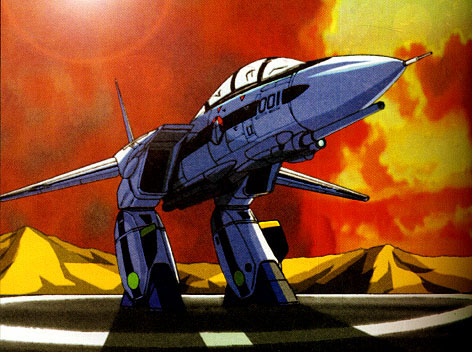
The VF-14A ‘Tigercat’ was the first Terran success at applying
Robotechnoloy to existing conventional aircraft designs and was the predecessor of the
VF-1A ValkyrieVeritech Fighter. For almost six years, the United Earth Government’s
Research Team, headed by Dr. Emil Lang worked to unravel the mysteries of the technology
of the crashed SDF-1. Finally, almost seven years after the crash, Dr. Lang felt that
enough information from the SDF-1 was understood to apply it’s technology. After
fierce competition from General Dynamics, Lockheed, Northrop and several other major
aeronautical corporations, the UEG sold the design contract the Grumman Corporation, a
large and trusted supplier of United States Naval combat aircraft for many years before
and during the Global Civil War. The design teams of Grumman, pressured to produce a
prototype as soon as possible, looked to modify their aging F-14 ‘Tomcat’ design
instead of building a new design from scratch. They began by first upgrading an F-14D with
the latest communication and sensor systems that the UEG’s Research and Development
branches had come up with in the past few years. The most significant of all changes was
the addition of a new type of power source and Central Computing Unit, which Dr. Lang and
his elite Research Team revealed little information about. The first prototype, simply
called the ‘YF-X14’ first flew 11 May, 2006 and performed magnificently.
Unfortunately, during a follow-up test flight four days later, the aircraft’s engines
stalled at a low altitude during a touch and go exercise, causing the prototype to crash
killing the test pilot.
A mere two weeks later, Dr. Lang and his team approached a new high technology
corporation, Arumon, to specially construct a radical engine design they had created. The
UEG assigned a rising officer, Lisa Hayes, to act as the liason between the two civilian
corporations and see that the deadlines were met. Two months and over 50,000 man-hours
later, two prototype Arumon vectoring engines were completed. The Research Team then
presented the engine to the Grumman Engineers and ordered them to incorporate it into the
F-14D’s airframe. By 3 October, 2006, the second prototype called the YVF-X14 rolled
out of the production line. Lang’s Research Teams briefly explained that the
‘V’ in the designation was due to a new ‘variable technology’ feature
of the fighter. The aircraft’s maiden flight was a week later on 10 October. The new
test pilot for the program, Lt.(jg) Roy Fokker, handled the aircraft superbly and
successfully demonstrated the unique characteristics of the aircraft. He reconfigured the
aircraft by extending it’s reverse articulated legs and demonstrated it’s new
found VTOL capabilities. The first variable technology machine, or ‘Veritech
Mecha’ was an enormous success.
The UEG placed orders for several more prototypes that could test the new configuration,
or “Guardian configuration” as Dr. Lang’s team called it. By quickly
modifying airframes, the Grumman Corporation completed the next prototypes, officially
called the YVF-14A ‘Tigercat’ which rolled out of the production line 1 January,
2007. Lt. Roy Fokker was at the controls and took the first machine through it’s
maiden flight a week later. While the Grumman Engineers slaved to build the
‘Tigercat’, Dr. Lang was secretly putting the finishing touches on a brand new
dynamic and revolutionary design based on elements of the successful ‘Destroid’
program. Immediately after the successful flight of the ‘Tigercat’, the UEG
contracted Grumman to quickly build a prototype of Lang’s new three-form design,
theVF-X1. The YVF-X1 ‘Valkyrie’ prototype flew on 27 March, 2007. The
‘Tigercat’ prototype, made it’s final flight to the UEG’s secret
storage facility, or ‘museum’ May 11th, 2008, two years after the first flight
of the YF-X14.
RPG STATS
- Vehicle Type: YVF-14A Tigercat
- Class: Variable Fighter
Manufacturer: Robotech Defense Forces
Crew: One pilot and one weapons officer both wearing Tactical Life Support System.
MDC BY LOCATION:
| Location |
Tigercat |
| 40 mm Cannon |
10 |
| Legs/Engine Thrusters |
75 |
| (1) Main Body |
150 |
| Reinforced Pilots Compartment |
100 |
| Wings (2) |
50 |
| Fins (2) |
25 |
| Tails (2) |
25 |
NOTES:
- Depleting the MDC of the main body will destroy the mecha.
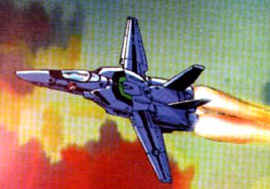
SPEEDS:
- FLYING, GERWALK/SOLDIER CONFIGURATION:
- Mach 1.1 (1200 kmph) maximum speed limit in an Earth-like atmosphere. Can also hover in
place indefinitely.
- FLYING, FIGHTER CONFIGURATION:
- Max level speed at sea level : Mach 1.4
Max level speed at 10km: Mach 3.2
Max level speed at 30+ km: Mach 7
- Stall speed : 182 kph (VTOL rectification possible)
- Range: 2000 km
Initial climb rate : over 25000m per minute
Service ceiling : 30 km (unboosted).
MAX ENGINE THRUST:
- Two Arumon TF69-A-707B Vectoring Turbofans: each engine is rated at
38,200 lbs of thrust each with augmentors
STATISTICAL DATA:
- HEIGHT:
- 6.93m in gerwalk configuration.
- 4.90m in fighter configuration.
- WIDTH:
- 19.5m with wings outswept
- LENGTH:
- . 20.6m
- WEIGHT:
- 13000 kg empty.
- PHYSICAL STRENGTH:
- Equal to a P.S. of 40
- CARGO:
- Small compartment behind pilot's seat for personal belongings.
-
- COMPATIBLE FAST PACKS:
- None
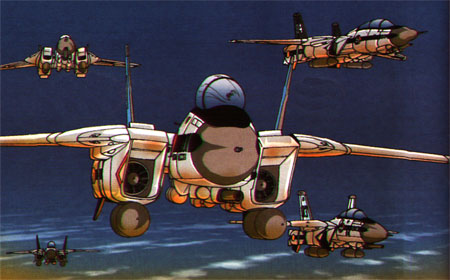
WEAPON SYSTEMS:
- 1 x 40MM M99-A1 ANTI-TANK CANNON: A single 40mm cannon is mounted underneath the
fuselage. The gun can fire 300 rounds per minute and has a 200 round capacity stored
internally.
- PRIMARY PURPOSE: Assault
- SECONDARY PURPOSE: Anti-Mecha
- RANGE: Armor Piercing Spin Stablized Discarding Sabot (APSSDS) (1200 m), or
3937ft (1000m) for all others.
- DAMAGE: APSSDS 2d6 short burst, 4d6 medium burst, 1d4*10 full melee burst.
HEAP 3d6 short burst, 6d6 medium burst, 2d4*10 full melee burst. Tracer
rounds reduce damage by 25%. Standard 3d6 short burst, 5d6 medium burst, or
1d6*10 full melee burst
- RATE OF FIRE: Single shots or bursts equal to the combined attacks of the pilot.
- PAYLOAD: 200 rounds of internal ammunition or 20 short bursts, 10 medium, or 5
full melee.
- NOTES: APSSDS crits on 17,18,19,20. HEAP crits on 19,20.
Tracers add +2 to strike.
- 1 x 20MM M61-A1 CANNON: A single 20mm cannon is mounted underneath the fuselage
on the left side. The gun can fire 600 rounds per minute and has a 400 round
capacity stored internally.
- PRIMARY PURPOSE: Assault
- SECONDARY PURPOSE: Anti-Mecha
- RANGE: 1000 m
- DAMAGE: 1d6 for short bursts, 3d6 medium bursts, and 6d6 for each full melee
bursts
- RATE OF FIRE: Bursts equal to the combined attacks of the pilot.
- PAYLOAD: 600 rounds of internal ammunition or 60 short bursts, 30 medium or 15
full melee bursts.
- 6 x BODY HARD POINTS: Four body hard points are mounted between the engines and
two are mounted below each engine mount. Each hard point can carry 1 missile of any
type or 500 kg of bombs. Any missiles mounted on the two hard points below the
engines must be fired before the Tigercat can transform.
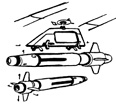
- 4 x WING HARD POINTS: Two hard points are mounted on each wing. Each hard point
can mount 15 short range, 5 medium, 2 long range missiles, or 500 kg of bombs.
- HAND TO HAND COMBAT: If necessary, the Tigercat can engage in melee combat rather
than use a weapon. Without a dedicated battleloid mode the Tigercat only possesses limited
hand to hand abilitys.
DAMAGE:
- Kick: 3D6*3
- Leap Kick: 6D6*3
- Body Block/Tackle: 3D6*3
- Stomp: 6D6*3 . (only effective against small objects)
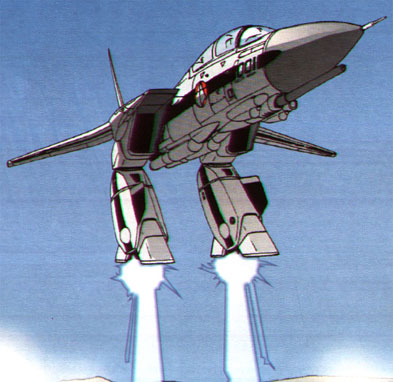
STANDARD EQUIPMENT FOR THE TIGERCAT:
- AUTO-PILOT: The Tigercat is equipped with a computerized auto-pilot, allowing the
pilot to relax or even sleep during long voyages. The auto- pilot can be programmed with a
single destination or a complex flight plan involving multiple speeds, directions, and
destinations. The onboard computer will alert the pilot when the fighter is near its
destination, and can also be set to automatically signal when sensors detect objects near
the mecha.
- COMBAT COMPUTER: The combat computer tracks and identifies specific enemy
targets, and has a database of over 250 images stored in memory. The computer can identify
and track up to 25 targets simultaneously.
- EXTERNAL AUDIO PICKUP: Range: 300 ft (91.5 m). A sound amplification system that
can pick up normal conversation up to 300 feet away.
- HEAT AND RADIATION SHIELDS: Special shielding prevents the penetration of life
threatening head and radiation. A radiation detection and alarm system are linked with the
shields and will sound an alarm if there is a rupture in the shields and what the levels
of radiation are.
- LASER TARGETING SYSTEM: Range: 100 miles (160 km). Used for increased accuracy in
the striking of enemy targets and is partly responsible for the mecha's strike bonus.
- LOUDSPEAKER: A loudspeaker system is built into the craft, which can be used to
amplify the pilot's voice up to 90 decibels.
- OPTICS: INFRARED: Range: 2000 feet (610 m). This optical system projects a beam
of infrared light that is invisible to the normal eye, but detectable by the mecha's
sensors. The system allows the pilot to detect hidden/concealed objects by their IR
reflectiveness. The beam will be visible to anyone with IR sensitive optics, however.
- OPTICS: THERMAL IMAGER: Range: 2000 feet (610 m). A passive optical heat sensor
that detects infrared radiation projected by warm objects and converts that data into a
false-color visible image. The system enables the pilot to see in the dark, in shadows,
and through smoke, and also adds a +10% bonus to pilots using a tracking skill.
- AN/APG 100 "BEE-EYE" RADAR: 200 mile range.
- RADIO/VIDEO COMMUNICATION: Long range, directional communications system with
satellite relay capabilities. Range: 600 miles (960 km) or can be boosted indefinitely via
satellite relay.
- SELF-DESTRUCT: To prevent capture of an advance variable fighter by the enemy,
the pilot can activate theTigercat self-destruct system, which will cause the fighter to
explode after a delay of up to 60 minutes (time is set by the pilot). The explosive damage
is contained within a 20 foot (6 m) area and inflicts 1D6x10 M.D. to everything within the
radius of the explosion. All internal systems are obliterated. The escape pod will be
automatically ejected prior to the explosion unless the pilot overrides the ejection
sequence.
- STANDARD SURVIVAL KIT: Inside the small reinforced box is a medium-sized
flashlight, two hand flares, one rocket flare, a compass, infrared distancing binoculars,
a small mirror, a pocket knife, dehydrated and concentrated food (can be stretched into a
five day supply for one person) and basic first aid items (aspirin, bandages,
disinfectants, etc.)
- TACTICAL LIFE SUPPORT SYSTEM: The Tigercat cockpit is pressurized, and also
provides additional air feeds to the pilot's flight suit that provides him with
pressurized breathing. The REF flight suit also contains an upper and lower g-suit that
promotes blood circulation even during high-g turns, thus decreasing the possibility of
pilot's blacking out in combat.
- GRUMMAN Q-16 ACTIVE SENSOR JAMMER
- CHAFF AND FLARE DISPENSER:12 chaff and 12 flares are stored in each
lower leg
COMBAT BONUSES FOR TIGERCAT TRAINING:
- 2 attacks per melee (plus those of the pilot).
- Add one additional action/attack at levels six and eleven.
- +1 to strike
- +3 in guardian, and +5 in jet mode.
- +2 to roll with a punch or fall with an impact, reducing damage by half.
- Critical strike same as pilot's hand-to-hand.
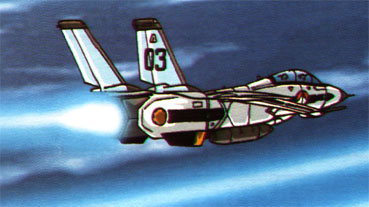
REFERENCES USED IN THIS DESIGN
- Robotech Technical Files: Veritech Valkyrie
- Palladium Books: "Robotech The Roll Playing Game"
- The Robotech Page:
Tigercat entry by Macross
Back to Mecha Home






